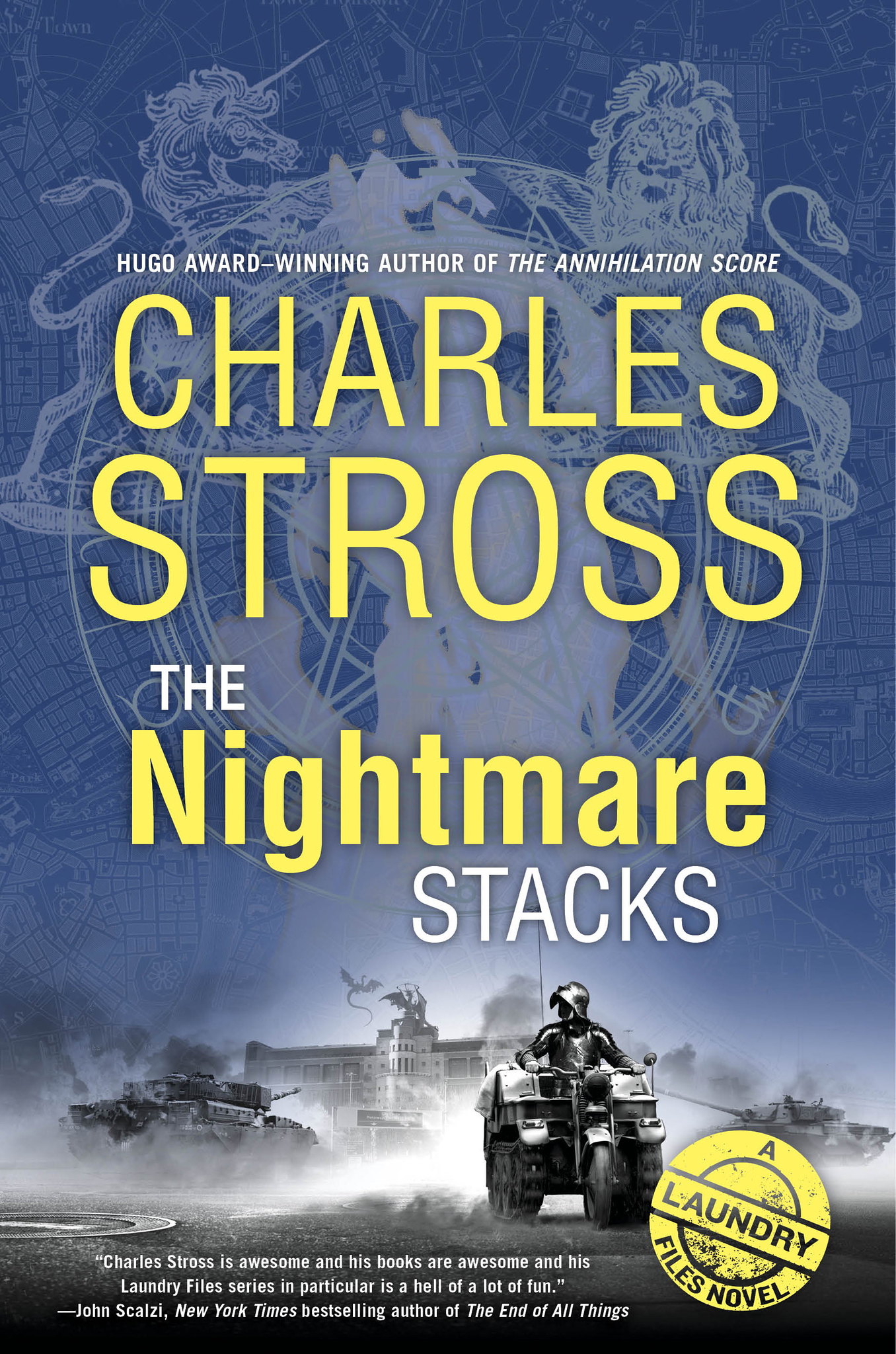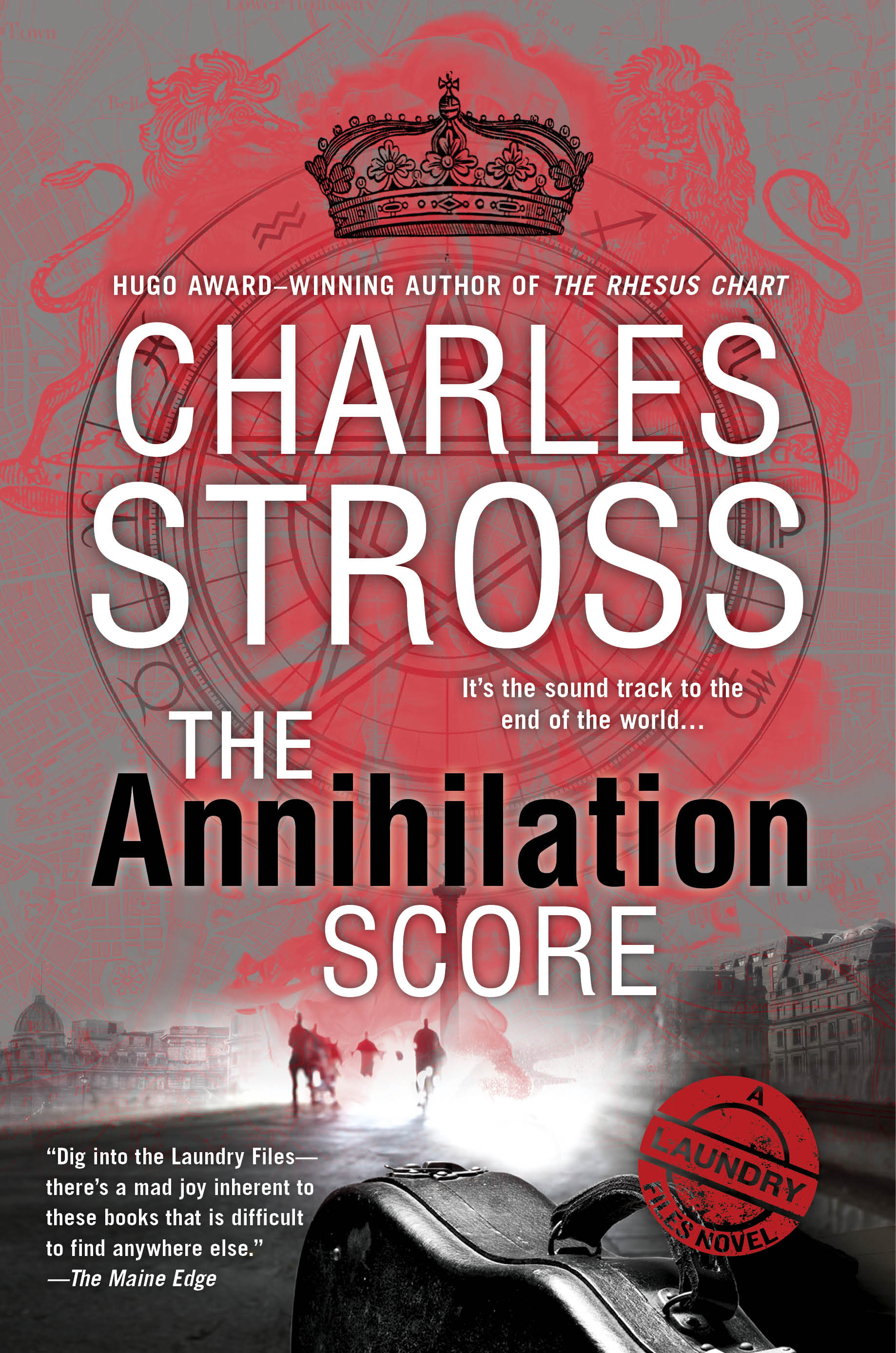 |
| American Edition Cover |
In my
November 11, 2015, blog post I was reading Charles Stross's
The Nightmare Stacks
, the next volume (#7) in the Laundry Files series, in preparation for actually working on the manuscript. That time has (had) come.
If you are new (seriously?) to the Laundry Files: Officially known as "Q-Division" (at least for now), the Laundry was part of the Strategic Operations Executive (SOE), a World War II British organization responsible for espionage and sabotage in occupied Europe. The Q-Division was a supersecret black group formed to counter Hitler's research and experiments in the occult. At the end of WWII, the SOE was disbanded, but the Q-Division secretly remained intact. The new headquarters was then located above a Chinese Laundry, and thus the nickname. These days, the Laundry's primary objective is to protect the citizens of Her Majesty's Government from incursions from beyond spacetime. But the Laundry must also defend against one who attempts to take over the world (The Jennifer Morgue), the cultlike church who tries to force the Second Coming (The Apocalypse Codex), individuals with V syndrome (The Rhesus Chart), and individuals with superpowers (The Annihilation Score).
Now, as revealed in The Atrocity Archives, the first volume in the series, shortly before the end of the war in Europe, members of the Ahnenerbe-SS used occult measures to open a gateway to a nitrogen-based planet, to which they escaped, to bide their time until they were ready to return to Earth -- and the termination of that return fell upon the Laundry.
In fact, if you look at the graphic above of the American edition of The Nightmare Stacks you'll see a Kettenkrad on the cover -- a German motorized half-track, small enough to be steered like a motorcycle. The Kettenkrad was salvaged from the Ahnenerbe-SS by the Laundry, and rebuilt by Pinky and Brains (readers of the series will recognize this pair of R&D tech geeks from previous volumes), and both Pinky and Brains, and the Kettenkrad, are integral parts of the story in this forthcoming novel, scheduled to be published in June. (And yes, the driver of the Kettenkrad is wearing seventeenth-century cavalry plate, and that is a dragon flying above the building on the cover. But you'll just have to wait for the novel....)
 |
| British Edition Cover |
Through the first five volumes of the Laundry Files, we've been following agent Bob Howard: officemate, IT geek, and occult mathematician -- and now Eater of Souls. (Volume five,
The Apocalypse Codex, being the exception, in which we were also treated to the POVs of external assets Persephone Hazard, aka agent Bashful Incendiary, and Jonathan McTavish, aka agent Johnny Prince.) Volume six was completely from the viewpoint of Dr. Dominique "Mo" O’Brien (aka agent Candid), a professor and combat epistemologist, who just happens to be married to Bob Howard. But this new volume,
The Nightmare Stacks, is neither a Bob novel, nor a Mo novel, but rather "a Laundry novel," as the author Charles Stross states in his
November 4, 2015, blog post. Rather, the new novel features operative-in-training Alex Schwartz, who was "drafted" by the Laundry "after stumbling upon the algorithm that turned him and his fellow merchant bankers into vampires." (see
The Rhesus Chart)
I spent the majority of December working on the manuscript -- and with the start of the new year, my editing was complete, and the marked-up manuscript is now in the hands of the author. I just checked my email, and counted 108 emails (though there could be a few more that I may have simply overlooked) between the two of us as I worked on this project, far fewer than is typical, based on prevous volumes. However, this time, I didn't confer with Charlie on every major content change -- with seven volumes now, I have to
hope that I know what I'm doing (!) and will leave the final decisions to the author when he reviews my edits.
You'll want to read the Stross interview on
The Nightmare Stacks, courtesy of
io9 -- but I suggest you read the version posted on the
author's blog: the interview is the same, but it's Charlie's comments and notes, plus the 79 comments at the end (including the author's responses) that are the most revealing about the book.
As I mentioned in my
blog post on editing
The Annihilation Score, which was published last July, the most difficult task is maintaining consistency from one volume to the next, and with seven volumes of the Laundry Files now, the task certainly isn't getting any easier. In fact, you would be surprised were I to tell you the email discussion Charlie and I had over the Laundry's official name -- Q-Division -- and what that entailed and what it will lead to, most likely in the next novel (volume eight, 2017's
The Delirium Brief).
But for the sake of consistency and understanding, let me share a set of words with readers: a geas (plural: geases) is a magical compulsion to obedience. Readers of the Laundry files series will have come upon this word in nearly every volume. However, in The Nightmare Stacks, we encounter a new race, the alfär, or the unseelie, and in their Low Tongue, the word for a magical compulsion to obedience is also geas, but the plural form is geasa. Something to keep in mind when you read the novel...You never know when this kind of trivia may prove useful!
The Nightmare Stacks
is forthcoming from Ace in the U.S. and Orbit in the U.K. and is currently available for preorder.








